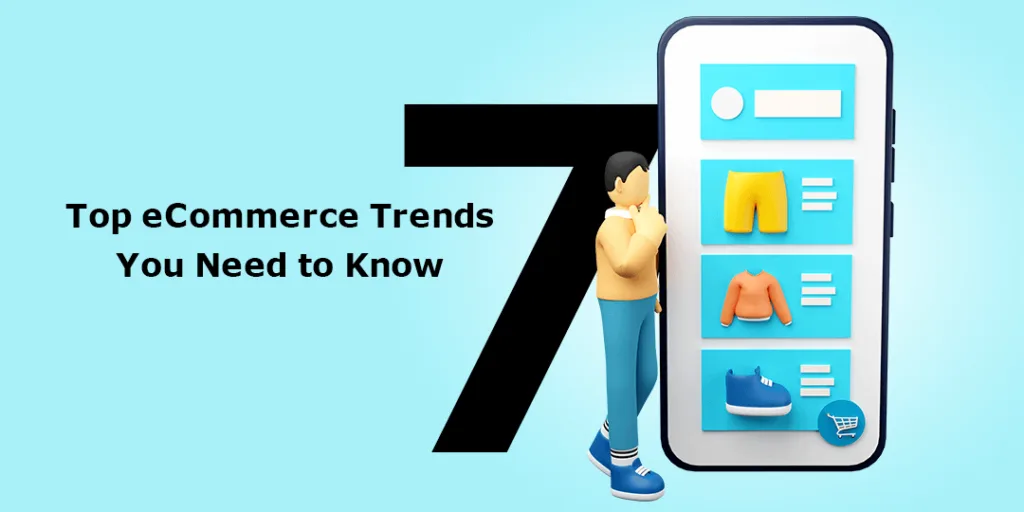The eCommerce industry is everlastingly growing and developing. The pandemic has forced more and more businesses to move online.
With these changes, eCommerce merchants need to stay updated with modern trends. eCommerce businesses must keep up with the changing tendencies to stay updated and competitive. Acting slowly means dropping sales.
Hence, we have gathered top eCommerce trends that will shape the eCommerce businesses in the coming months and years.
Top 7 eCommerce Trends You Need to Know in 2022
Let’s break down the prime eCommerce trends affecting the eCommerce marketplace in 2022 and beyond.
Augmented and Virtual Reality
Augmented Reality (AR) and Virtual Reality (VR) solve customers’ problems quickly while shopping online. Ar helps customers to try on products virtually and know how they will look in real life. This will help them in making a buying decision.
AR is a game-changer for specific industries like fashion and home decor. Various businesses are adopting AR and VR to offer engaging shopping experiences to customers.
Look at the below statistics,
- 71% of customers say they are more likely to purchase from a brand that provides a real experience of shopping.
- 17% of businesses have witnessed a growth in conversion rate using VR.
Buy Now Pay Later (BNPL) Model
The BNPL (Buy Now Pay Later) Model has become popular after the COVID-19 pandemic. Due to the pandemic, people became jobless and suffered from the financial crisis. The BNPL payment model proved to be useful for such customers.
With BNPL payments, customers can buy the product and can pay later. Instead of paying at the time of purchase, customers can pay in installments or credit cards with zero interest afterward. Amazon Pay Later is an example of a BNPL payment.
With BNPL, sellers have experienced a boost in sales, more order quantity, quick order processing, and a lesser abandonment rate.
Varied Payment Options
Payment is the last step in the purchasing process and if the customers cannot find their desired payment method, they might cancel a purchase. For store owners, there is nothing worse than a customer abandoning the cart.
Provide diverse payment options to customers to minimize cart abandonments due to the absence of preferred payments. Allow customers to save their payment information on your website so that the next time when they make a purchase from your webshop, they can checkout with a single click.
Include payment methods like digital wallets, credit cards, debit cards, and cryptocurrency, and also accept payments in installments.
Sustainable Commerce
Today’s consumers prefer businesses that take care of the environment for production, packaging, and delivery. The number of customers who support sustainability is increasing day by day, so eCommerce merchants cannot escape from this trend.
Businesses are trying to stay eco-friendly by using biodegradable products, recycling supplies, and going paperless. 8 out 0f 10 consumers look for sustainability while making purchase decisions. Therefore, eCommerce businesses have no option other than to shift to sustainable products and packaging.
As consumers and businesses are becoming more conscious of the environment, adopting sustainability is mandatory in the coming future.
Headless Commerce
Headless commerce allows separating the frontend and backend of any website or application. Using an application programming interface (API) content like products, blogs and reviews can be delivered to any front-end framework.
Headless commerce widens the shopping channels. Consumers can buy not only using laptops, computers, or mobile but also through smart speakers and smart fitness devices.
Thus, headless commerce integrates various shopping experiences, enhances shopping flexibility, and opens up more sales channels. With headless commerce, as new sales channels can be added easily, it helps in improving the omnichannel experience.
Conversational Commerce
Selling products to customers using chatbots or any other messaging platform is termed conversational commerce.
While shopping offline, a sales associate is with you to answer all your questions. But while shopping online there is no one to answer the queries. Here comes the real use of chatbots. In this fast world, customers want to buy products quickly. If they cannot find anyone to inquire, they will get frustrated.
Hence, chatbots work as a savior for eCommerce stores to answer customer doubts quickly. Live chat keeps you always on for customers and provides a personalized experience.
Voice Search
People are placing online orders even while driving. Voice search makes the shopping hassle-free and painless by typing the query in the search bar.
58% of users use voice search to find a local business. More and more consumers are using voice search to shop online or order food.
eCommerce businesses must look for ways to integrate voice search into their marketing strategies. Make sure your products and services rank for keywords used for voice search queries. Usually, people speak complete sentences instead of phrases while using voice search.
Summing Up:
New trends are being adopted to ensure a smooth customer journey and shopping experience. Many trends only apply to some types of business so it is necessary to understand your customers first.
It’s never too late to opt for a change that benefits your business and customers. Apart from the above-discussed trends, check out other eCommerce trends that will improve the efficiency of your business.
